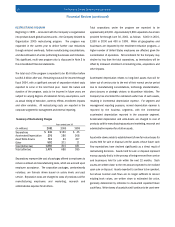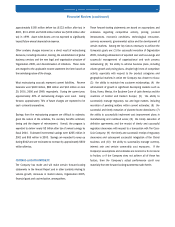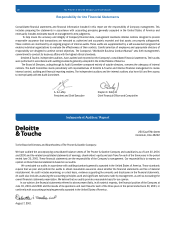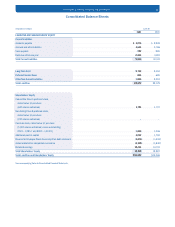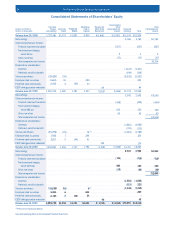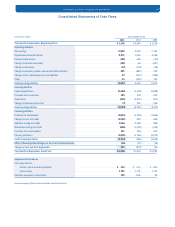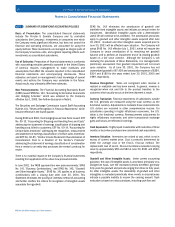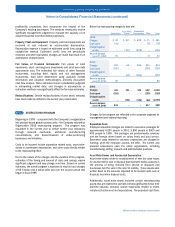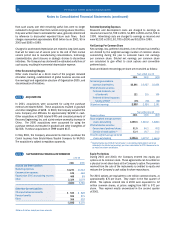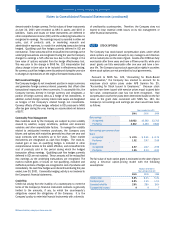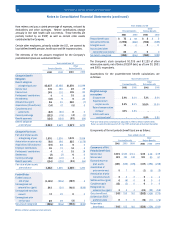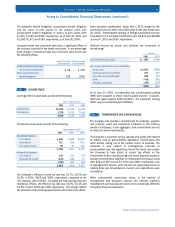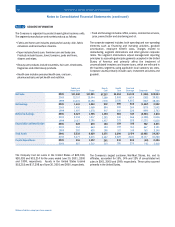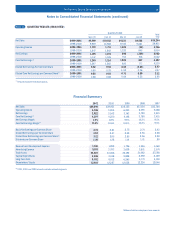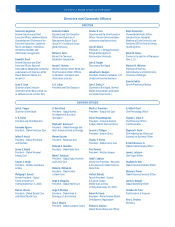Proctor and Gamble 2001 Annual Report Download - page 28
Download and view the complete annual report
Please find page 28 of the 2001 Proctor and Gamble annual report below. You can navigate through the pages in the report by either clicking on the pages listed below, or by using the keyword search tool below to find specific information within the annual report.
SFAS No. 142 eliminates the amortization of goodwill and
indefinite-lived intangible assets and initiates an annual review for
impairment. Identifiable intangible assets with a determinable
useful life will continue to be amortized. The amortization provisions
apply to goodwill and other intangible assets acquired after June
30, 2001. Goodwill and other intangible assets acquired prior to
June 30, 2001 will be affected upon adoption. The Company will
adopt SFAS No. 142 effective July 1, 2001, which will require the
Company to cease amortization of its remaining net goodwill
balance and to perform an impairment test of its existing goodwill
based on a fair value concept. Although the Company is still
reviewing the provisions of these Statements, it is management’s
preliminary assessment that goodwill impairment will not result
upon adoption. As of June 30, 2001, the Company has net
unamortized goodwill of $7,429 and amortization expense of $224,
$214 and $180 for the years ended June 30, 2001, 2000 and
1999, respectively.
Revenue Recognition: Sales are recognized when revenue is
realized or realizable and has been earned. In general, revenue is
recognized when risk and title to the product transfers to the
customer, which usually occurs at the time shipment is made.
Currency Translation: Financial statements of subsidiaries outside
the U.S. generally are measured using the local currency as the
functional currency. Adjustments to translate those statements into
U.S. dollars are recorded in other comprehensive income. For
subsidiaries operating in highly inflationary economies, the U.S.
dollar is the functional currency. Remeasurement adjustments for
highly inflationary economies and other transactional exchange
gains and losses are reflected in earnings.
Cash Equivalents: Highly liquid investments with maturities of three
months or less when purchased are considered cash equivalents.
Inventory Valuation: Inventories are valued at cost, which is not in
excess of current market price. Cost is primarily determined by
either the average cost or the first-in, first-out method. The
replacement cost of last-in, first-out inventories exceeded carrying
value by approximately $55 and $83 at June 30, 2001 and 2000,
respectively.
Goodwill and Other Intangible Assets: Under current accounting
guidance, the cost of intangible assets is amortized, principally on a
straight-line basis, over the estimated periods benefited, generally
forty years for goodwill and periods ranging from three to forty years
for other intangible assets. The realizability of goodwill and other
intangibles is evaluated periodically when events or circumstances
indicate a possible inability to recover the carrying amount. Such
evaluation is based on various analyses, including cash flow and
NOTE 1 SUMMARY OF SIGNIFICANT ACCOUNTING POLICIES
Basis of Presentation: The consolidated financial statements
include The Procter & Gamble Company and its controlled
subsidiaries (the Company). Investments in companies over which
the Company exerts significant influence, but does not control the
financial and operating decisions, are accounted for using the
equity method. These investments are managed as integral parts of
the Company’s business units, and segment reporting reflects such
investments as consolidated subsidiaries.
Use of Estimates: Preparation of financial statements in conformity
with accounting principles generally accepted in the United States
of America requires management to make estimates and
assumptions that affect the amounts reported in the consolidated
financial statements and accompanying disclosures. These
estimates are based on management’s best knowledge of current
events and actions the Company may undertake in the future.
Actual results may ultimately differ from estimates.
New Pronouncements: The Financial Accounting Standards Board
(FASB) issued SFAS No. 133, “Accounting for Derivative Instruments
and Hedging Activities” which was adopted by the Company
effective July 1, 2000. See further discussion in Note 6.
The Securities and Exchange Commission issued Staff Accounting
Bulletin 101, “Revenue Recognition in Financial Statements,” which
became effective in the fourth quarter.
During 2000 and 2001, the Emerging Issues Task Force issued: EITF
No. 00-10, “Accounting for Shipping and Handling Fees and Costs”
addressing the statement of earnings classification of shipping and
handling costs billed to customers; EITF No. 00-14, “Accounting for
Certain Sales Incentives” addressing the recognition, measurement
and statement of earnings classification of certain sales incentives;
and EITF No. 00-25, “Vendor Income Statement Characterization of
Consideration Paid to a Reseller of the Vendor’s Products”
addressing the statement of earnings classification of consideration
from a vendor to an entity that purchases the vendor’s products for
resale.
There is no material impact on the Company’s financial statements
resulting from application of the above new pronouncements.
In June 2001, the FASB approved two new pronouncements: SFAS
No. 141, “Business Combinations,” and SFAS No. 142, “Goodwill
and Other Intangible Assets.” SFAS No. 141 applies to all business
combinations with a closing date after June 30, 2001. This
Statement eliminates the pooling-of-interests method of accounting
and further clarifies the criteria for recognition of intangible assets
separately from goodwill.
26
Notes to Consolidated Financial Statements
The Procter & Gamble Company and Subsidiaries
Millions of dollars except per share amounts




